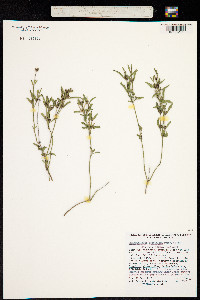Justicia longii
|
|
|
|
Family: Acanthaceae
Long-Flower Tubetongue, more...siphonoglossa, longflower tubetongue
[Adhatoda longiflora Torr., moreSiphonoglossa longiflora (Torr.) A. Gray] |
General: Erect subshrub or herb that freely branches above, 10–70 cm tall, emerges from rhizome, stems inconspicuously striate, with evenly pubescent hairs to 0.1 mm long, gray to brown and woody below, dark green to brown above. Leaves: Subsessile to petiolate, the leaves lanceolate to elliptic 3.5–5 cm long, 1–1.5 cm wide, the tip acuminate, falcate, or rounded, base attenuate to short petiole less than 1 cm long, dark green to olive above, pale dull green below, pubescent like the stems mostly along veins and margins. Flowers: Axillary, solitary or clustered, the flowers subtended by two obovate bracteoles that are linear to lance elliptic, 8–15 mm long, 1.5–3 mm wide, usually pubescent, the calyx with 5 deep lobes, 5.5–8.5 mm long, 1 cm long in fruit, sepals broadly lanceolate but constricted above calyx cup, 5–7.5 mm long, corolla white, zygomorphic with slenderly cylindric tube, about twice as long as lips, 2.5–4.5 cm long, scarcely widened above, upper lip reflexed and 6–8 mm long by 1.5–2.5 mm wide, the lower lip 3–parted and broadly spreading, each 9–10 mm long, 3–4.5 mm wide. Fruits: Contracted capsule 7–9 mm long, on stipe 2.5–3.5 mm long with small apical beak, glabrous and dark brown with 2–4 round and flattened seeds. Ecology: Found in rocky washes and arroyos in desert scrub from 3,000–5,000 ft (914–1524 m), flowers April–October. Distribution: Ranges from southern Arizona, from the Gila River in Graham County to Sinaloa near the Rio de Bavispe, with a disjunct population in Texas. Notes: Can be white or purple flowered (purple flowers found only at southern end of range), with long tubed corolla that opens in early evening. Hilsenbeck 1990 also reports it is pollinated by hawkmoths. Ethnobotany: Unknown Etymology: Justicia is named for James Justice (1698–1763) a Scottish botanist and horticulturalist, while longii is an honorific for Dr. Robert W. Long. Sources: Hilsenbeck 1990, Wiggins 1964, Daniel 1984 Hilsenbeck 1990, Wiggins 1964, Daniel 1984 Duration: Perennial Nativity: Native Lifeform: Forb/Herb General: Erect subshrub or herb from rhizomes and freely branching above, 10-70 cm tall; stems inconspicuously striate, gray to brown and woody below, dark green to brown above. Leaves: Opposite; subsessile or on a short petiole up to 1 cm; blades lanceolate to elliptic, 2-6 cm long, to 1.5 cm wide, the tip acuminate, falcate, or rounded, the base attenuate, margins undulate; dark green to olive above, pale dull green below; pubescent like the stems, hairs mostly along veins and margins. Flowers: Paired and subsessile in leaf axils; subtended by a pair of linear to lance-elliptic, pubescent bracteoles 8-15 mm long by 1-3 mm wide; calyx 5-9 mm long, with 5 subulate-linear segments; corolla white, 2-5 cm long, a 2-lipped, slenderly cylindric tube; upper lip reflexed, comprised of 1 notched segment 6-8 mm long by 2 mm wide; lower lip 3-parted and broadly spreading, each segment 9-10 mm long by 3-5 mm wide. Fruits: Capsule glabrous, 7-9 mm long, on stipe 3 mm long; each capsule with 2-4 dark brown, round, flattened seeds. Ecology: Found in rocky washes and arroyos in desert scrub from 3,000-5,000 ft (914-1524 m); flowers April-October. Distribution: Southern Ariz. from the Gila River in Graham County, south to Sinaloa, Mex. near the Rio de Bavispe, with a disjunct population in Texas. Notes: This white, tubular-flowered forb/ subshrub superficially resembles an Ipomopsis or Gilia (skyrockets). However it can easily be distinguished by its bilaterally symmetrical flowers, with one lobe pointing up and 3 lobes pointing down. Also look for the leaves which are linear in shape with slightly wavy edges. Can be white or purple flowered (purple flowers found only at southern end of range); the long tubed corolla opens in early evening. Hilsenbeck 1990 reports it is pollinated by hawkmoths. Ethnobotany: Unknown Etymology: Justicia is named for James Justice (1698-1763) a Scottish botanist and horticulturalist, while longii is an honorific for Dr. Robert W. Long. Synonyms: Siphonoglossa longiflora, Adhatoda longiflora Editor: SBuckley 2011, AHazelton 2015 |
|
|
|

































































































